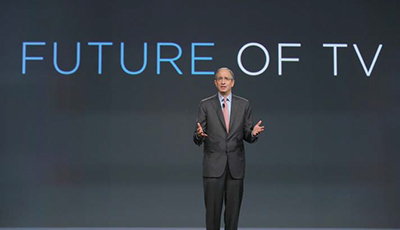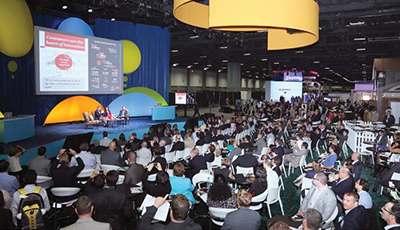The Cable Show: Tech in Tinseltown

Comcast CEO Brian Roberts will speak to the Cable Show on Wednesday morning.
LOS ANGELES—While chatter about the proposed Comcast/Time Warner Cable merger and the fast-escalating network affiliation fees will permeate the annual Cable Show the week of April 28, an array of technology and operating issues are also high on the agenda. Aereo, the broadcast TV via Internet delivery system, is not officially on the agenda, but it is also likely to be a prime discussion topic when the show opens, just days after the Supreme Court hearing on the legality of the service that challenges the cable and broadcasting industries’ financial and copyright structure.
Staging the annual convention in Hollywood’s backyard for the first time since 2011 will bolster awareness among the creative community, according to the National Cable and Telecommunications Association, which runs the event. Many entertainment producers have recently voiced greater interest in long-form, specialized cable platforms to distribute their show.
“Los Angeles is the perfect backdrop to explore the latest trends in entertainment and technology and to demonstrate how cable provides the most compelling platform for creative storytelling and the latest innovations,” said Michael Powell, president and CEO of NCTA. “As always, the show will bring together top technology influencers in broadband, entertainment, public policy and business to share what is inspiring the next big ideas throughout cable and beyond.”

NCTA will place a sharper spotlight on its now two-year-old “Imagine Park” showcase, an area within the exhibit hall where vendors and entrepreneurs will talk up their technologies and research findings in very brief pitches.MORE IMAGINE PARK
The two-and-a-half day agenda April 29- May 1 is packed with 200 speakers discussing regulatory policy, financial and business issues as well as a technology cornucopia. NCTA is putting a sharper spotlight on its now two-year-old “Imagine Park” showcase, an area within the exhibit hall where vendors and entrepreneurs will talk up their technologies and research findings in very brief pitches. The decades-old CableNet pavilion has about two dozen small exhibits—well below the numbers in previous years—mostly consisting of highly specialized technologies for cable networks, with a noticeable emphasis on nontraditional telecommunications services in voice and data delivery.
All five members of the Federal Communications Commission are expected to take part in programs during the convention, including Chairman Tom Wheeler, a long-ago president of NCTA, who will chat onstage with Powell, a former FCC chairman himself, on Wednesday morning. CEOs of Comcast, Time Warner, Cox Communications will appear on executive plenary sessions, chatting with their counterparts from AMC Networks, A&E Networks, Turner Broadcasting, plus top officials from Cisco and Disney.
Comcast Chairman and CEO Brian Roberts, the biggest name in the industry and getting bigger, will also make a Wednesday morning presentation.
Get the TV Tech Newsletter
The professional video industry's #1 source for news, trends and product and tech information. Sign up below.
NCTA expects 12,000 attendees, with the entertainment community in L.A. sending about 1,000, roughly matching the 1,000 local policymakers, mostly from federal agencies and Congressional staff, who stopped into last year’s convention in Washington, D.C., but will not make the California trek this month. Hence, the total turnout would remain in the same range as it has for several years, which is well below the nearly 30,000 attendees of the late ’90s, before industry consolidation reduced the industry’s executive and vendor ranks.
International attendance at the Cable Show has grown in recent years, and this year should represent about 10 percent of the turnout. Barbara York, NCTA’s senior vice president for industry affairs, credits the “high profile of Los Angeles” plus the participation of network presidents, such as top executives from Scripps Networks Turner Broadcasting, who have recently invested overseas.
An opening day Wall Street session with four veteran telecom/cable analysts will explore “industry restructuring” and where cable fits into the telecommunications landscape, especially in light of upcoming merger-and-acquisition dealmaking.
In addition to the FCC commissioners, other regulators and legislators will offer their views during four “policy” sessions. Speakers include state regulatory agency officials, FCC and Congressional communications subcommittee staff members and officials from other federal agencies. Other major convention sessions look at operations, programming and advertising.
WHERE THE TECHNOLOGY IS
Convention planners do not expect any breakthrough technology revelations at the Show; a canvass of exhibitors similarly indicated a low-key exhibit hall. Nonetheless, the conference agenda and exhibit halls are peppered with hints about where the industry is heading. Technical sessions and show floor/suite demonstrations are laden with ideas and products for the transition to the all-IP delivery system. Cable’s ability to carry Ultra High Definition TV as well as the growing “business services” category also figure heavily into the L.A. convention landscape.
“We have not just the traditional cable industry solution providers, but also other companies in this space,” said NCTA Vice President for Industry Affairs Mark Bell, who oversees program and exhibit activities. The roster includes data, voice, wireless and other technology providers looking to piggyback on cable’s high-speed backbone. In particular, Bell cites the growing focus on smart homes and wireless delivery as new directions in which cable technology is heading.
The industry is trying “to figure out how the networks scale for over-the-top, Internet TV and the IP transition,” Bell said. “We’re looking at the future of consumption because behaviors are shifting.”
Speakers at many sessions will examine “how companies have to change the ways they think... to deliver relevant services to people who now consume content quite differently,” Bell added, observing that “lines are blurring” among the various technologies and services that are now part of the cable industry package.
In particular, “TV Everywhere”—the long-simmering plan for multiplatform access—will be “reintroduced” via a new implementation that the Cable and Telecommunications Association for Marketing will introduce, based on consumer research. New CTAM President John Lansing will unveil a new TVE marketing campaign, which is expected to portray the authentication and access process as a user-friendly way to see cable content anywhere on any device.
Overall, the show’s 250 exhibitors— about the same number as last year—will display their wares in far less space: at 107,000 square feet, the convention show floor is about nine percent smaller than last year, possibly a sign of the times for a mature industry awaiting the next round of consolidation.
A dozen short sessions are scheduled at Imagine Park. Presentations are grouped by topics, such as the “Internet of Thingamajigs” [sic], featuring Qualcomm, Cisco and ARM executives, and “sticky screens,” demonstrated by presenters from Cox Communications, Rovi, Amdocs and Cisco, among others. At the “Better Television” session, executives from Dolby, Deluxe Digital, Ateme and Guitammer will look at UHD/4K, augmented picture quality and haptic interfaces. Other Imagine Park presentations will cover user experience, TV Everywhere, plus a “Best in Tech” session showcasing software developers’ visions about future cable technology.
Bell adds that the Park will include an Internet of Things lounge, featuring a device showcase and a collection of health and fitness wearables. The program also includes an Imagine Film Challenge, where student teams create short films to be judged by top entertainment influencers.
For more information on The Cable Show, visit http://2014.thecableshow.com.
Gary Arlen, a contributor to Broadcasting & Cable, NextTV and TV Tech, is known for his visionary insights into the convergence of media + telecom + content + technology. His perspectives on public/tech policy, marketing and audience measurement have added to the value of his research and analyses of emerging interactive and broadband services. Gary was founder/editor/publisher of Interactivity Report, TeleServices Report and other influential newsletters; he was the long-time “curmudgeon” columnist for Multichannel News as well as a regular contributor to AdMap, Washington Technology and Telecommunications Reports; Gary writes regularly about trends and media/marketing for the Consumer Technology Association's i3 magazine plus several blogs.

